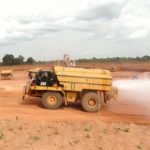These villages would benefit from a Fcfa 5.2 billion grant from the Islamic Development Bank.It would be fallouts of an agreement signed in 2007 with Cameroon authorities.
The official launching of this major accomplishment-type project took place in Obala, Lekie Division, on Friday November 18, 2011.
The intention is to connect electricity in these rural areas to the AES Sonel network which would allow a steady supply of power and proper monitor by professional staff of the cooperation. According to Ousmanou Moussa, Director of Rural Electrification Agency (AER), his body will provide “medium voltage lines, install transformers and connect all homes” in the said localities.This move falls within government’s policy to light up rural settings of the country as only 18 percent of Cameroon’s village communities have energy supply, according Micheal Ngako Tomdio, Minister of Energy, Mine and Water.Village households will soon see sunlight interchange with lamplight. “It’s the end of darkness in these villages,” Minister Tomdio said.On a wider scope, light would transform socio-economic life in these localities. Energy supply would promote existing economic activities and cause new ones to spring up. Food crops grown in surplus in these localities could be preserved for future retail. Telecommunication appliances would be put to use which would improve the standard of living of the said population. Local business persons can now plug phones on charge and remain in contact with their counterparts in metropolis. Cold stores would go operational in these villages while agricultural products could be transformed to fetch more income.The presence of electricity will save time and labour, solve problems of limited storage facilities and the difficulties of villagers who carry water and fuel by hand. The dangers of water borne diseases are inevitable in rural areas. But with energy fired pipe bone water and electric-powered water wells many such diseases can be prevented. Lack of electricity makes the rural population only productive in during the day.The country’s electricity suffers from unannounced frequent power cuts that damage appliances. The challenge would be to ensure regular flow of electricity. Also, the rural population is poor, so a “significant” reduction in connection cost and unit tariff is necessary.This project follows another rural electrification project valued at Fcfa 4.5 billion launched on August 12, 2008 in Idenau, West Coast District by the then Minister of Water and Energy, Jean Bernard Sindeu. The project which was expected to draw the curtains in 2008 had to cover 26 rural areas in the South West and North West regions. In the same light, 26 villages in the littoral region were connected to electricity by September 2009. 21 of these villages saw light for the first time while five others had their quality of electricity supply improved upon. Meanwhile, the potential Lom-Panger hydroelectric power project(to be completed by 2013) over the Sanaga River estimated at over 1500 megawatts will help to provide rural electrification to some 150 localities including administrative centers while connecting 10,000 new subscribers in the East Region of Cameroon to the national grid.
JUDE VIBAN,




